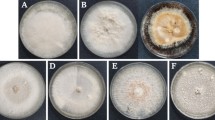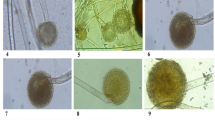Abstract
In the course of pre- and postharvest epidemiological studies on bulbs contamination byAspergillus niger, two Sudanese onion cultivars were tested: ‘Saggai Red’ and ‘El-Hilo White’.A. niger spores, whether seedborne, soilborne or airborne, were avirulent to the healthy growing onion plants. The fungus heavily contaminated the dead onion tissues, mainly the dead leaves followed by the dry scales, the dead roots and, to a lesser extent, the bulb necks, preferring the red-skinned cultivar to the white one. The initial spores carried from naturally contaminated field soil on the dead tissues could germinate and produce massive numbers of new spores on bulbs stored at average climatic conditions of Sudan (23–39°C, 29–93% relative humidity). Under laboratory-controlled conditions, optimal growth occurred at 75–85% r.h. on bulbs with dry scales and maximum losses occurred at 100% r.h. and ambient temperature. Underin vitro conditions, the optimal growth and sporulation temperature forA. niger was in the range of 30–35°C. Early harvesting and removal of the dead onion tissues improved bulb storability in aseptic stores under low temperature and relative humidity conditions.
Similar content being viewed by others
References
Anderson, J.G. and Smith, J.E. (1972) The effect of elevated temperatures on spore swelling and germination ofAspergillus niger.Can. J. Microbiol. 18:289–297.
Brice, J., Currah, L., Malin, A. and Bancroft, R. (1997) Onion storage in the tropics: A practical guide to methods of storage and their selection. The University of Greenwich, Natural Resources Institute, Chatham, UK.
Ceponis, M.J., Cappellini, R.A. and Lightner, G.W. (1986) Disorders in onion shipments to the New York market 1972–1984.Plant Dis. 70:988–991.
Collins, C.H. and Taylor, C.E.O. (1967) Microbiological Methods. Butterworth, London, UK.
Currah, L. (1989) Onion research and development in Brazil.Onion Newsl. Tropics 1:24–26.
Datar, V.V. and Mulekar, V.G. (1989) Investigations on post-harvest decay of onion (Allium cepa L.) in India.Onion Newsl. Tropics 1:27–30.
El-Nagerabi, S.A.F. and Ahmed, A.H.M. (2001) The effect of black mold (Aspergillus niger) on two Sudanese cultivars of onion.Trop. Sci. 41:95–99.
Grover, D.W. and Nicol, J.M. (1940) Measurement of vapour pressure of glycerol solutions by determining the dew point of the air in equilibrium with the solutions.J. Soc. Chem. Ind. 59:175–177.
Hayden, N.J. (1989) Observations on harvesting and storing onions in Northern Sudan.Onion Newsl. Tropics 1:19–23.
Hayden, N.J. and Maude, R.B. (1992) The role of seedborneAspergillus niger in transmission of black mold of onion.Plant Pathol. 41:573–581.
Hayden, N.J., Maude, R.B., El-Hassan, H.S. and Abdel-Magid, A.A. (1994) Studies on the biology of black mold (Aspergillus niger) on temperate and tropical onions. 2. The effect of treatments on the control of seedborneA. niger.Plant Pathol. 43:570–578.
Hayden, N.J., Maude, R.B. and Proctor, F.J. (1994) Studies on the biology of black mold (Aspergillus niger) on temperate and tropical onions. 1. A comparison of sources of the disease in temperate and tropical field crops.Plant Pathol. 43:562–569.
ISTA (1966) International rules for seed testing.Seed Sci. Technol. 4:3–49.
Kale, P.N., Warade, S.D. and Jagtap, K.B. (1991) Effect of different cultural practices on storage life of onion bulbs.Onion Newsl. Tropics 3:25–27.
Köycü, N.D. and Özer, N. (1997) Determination of seedborne fungi in onion and their transmission to onion sets.Phytoparasitica 25:25–31.
Maude, R.B., Lyons, N.F., Curd, L., El Muallem, A.B. and Bamakrama, H. (1991) Disease problems of onions in the Republic of Yemen.Onion Newsl. Tropics 3:34–38.
Musa, S.K., Habish, H.A., Abdalla, A.A. and Addlan, A.B. (1973) Problems of onion storage in the Sudan.Trop. Sci. 5:319–327.
Narain, A. and Prakash, O. (1968) Toxic metabolite ofAspergillus niger and its role in onion rot disease.Indian Phytopathol. 12:217–220.
Özer, N. and Köycü, N.D. (1998) Evaluation of seed treatments for controllingAspergillus niger andFusarium oxysporum on onion seeds.Phytopathol. Mediterr. 37:33–40.
Prakash, O. and Siradhana, B.S. (1974) Effect of temperature, hydrogen ion concentration and some media on fourAspergillus species isolated from maize grain.Indian Phytopathol. 31:545–547.
Rabinowitch, H.D. and Brewster, J.L. [Eds.] (1990) Onion and Allied Crops. Vol. 3. CRC Press, Boca Raton, FL, USA.
Rao, C.V. and Rajasab, A.H. (1992) Investigations on black mold (Aspergillus niger) of onion.Onion Newsl. Tropics 4:66–67.
Ray, S.K.D., Kabir, J., Chatterjee, R. and Mitra, S.K. (1991) Effect of pre-harvest foliar spray of some chemicals on storage behaviour of onion.Onion Newsl. Tropics 3:23–25.
Sherf, A.F. and Macnab, A.A. (1986) Vegetable Diseases and Their Control. Wiley, New York, NY.
Snowdon, A.L. (1990) A Color Atlas of Post-harvest Diseases and Disorders of Fruits and Vegetables. Vol. 1. Wolfe, London, UK.
Stow, J.R. (1975) Effect of humidity on losses of bulb onions (Allium cepa L.) stored at high temperature.Exp. Agric. 11:81–87.
Author information
Authors and Affiliations
Corresponding author
Additional information
http://www.phytoparasitica.org posting Oct. 20, 2003.
Rights and permissions
About this article
Cite this article
El-Nagerabi, S.A.F., Ahmed, A.H.M. Storability of onion bulbs contaminated byAspergillus niger mold. Phytoparasitica 31, 515–523 (2003). https://doi.org/10.1007/BF02979744
Received:
Revised:
Accepted:
Issue Date:
DOI: https://doi.org/10.1007/BF02979744




